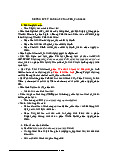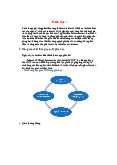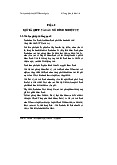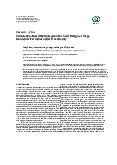












Preview text:
Question 1 ( Single Topic )
What is the difference between a RIB and a FIB?
A. The FIB is populated based on RIB content.
B. The RIB maintains a mirror image of the FIB.
C. The RIB is used to make IP source prefix-based switching decisions.
D. The FIB is where all IP routing information is stored. Answer : A
Question 2 ( Single Topic )
Which QoS component alters a packet to change the way that traffic is treated in the network? A. policing B. classification C. marking D. shaping Answer : C
Question 3 ( Single Topic ) DRAG DROP -
Drag and drop the descriptions from the left onto the correct QoS components on the right. Select and Place: Answer :
Question 4 ( Single Topic )
Which statement about Cisco Express Forwarding is true?
A. The CPU of a router becomes directly involved with packet-switching decisions.
B. It uses a fast cache that is maintained in a router data plane.
C. It maintains two tables in the data plane: the FIB and adjacency table.
D. It makes forwarding decisions by a process that is scheduled through the IOS scheduler. Answer : C
Question 5 ( Single Topic )
What is a benefit of deploying an on-premises infrastructure versus a cloud infrastructure deployment?
A. ability to quickly increase compute power without the need to install additional hardware
B. less power and cooling resources needed to run infrastructure on-premises
C. faster deployment times because additional infrastructure does not need to be purchased
D. lower latency between systems that are physically located near each other Answer : D
Question 6 ( Single Topic ) DRAG DROP -
Drag and drop the characteristics from the left onto the appropriate infrastructure deployment types on the right. Select and Place: Answer :
Question 7 ( Single Topic )
How does QoS traffic shaping alleviate network congestion?
A. It drops packets when traffic exceeds a certain bitrate.
B. It buffers and queues packets above the committed rate.
C. It fragments large packets and queues them for delivery.
D. It drops packets randomly from lower priority queues. Answer : B Reference:
https://www.cisco.com/c/en/us/support/docs/quality-of-service-qos/qos-policing/19645- policevsshape.html
Question 8 ( Single Topic )
An engineer is describing QoS to a client.
Which two facts apply to traffic policing? (Choose two.)
A. Policing should be performed as close to the source as possible.
B. Policing adapts to network congestion by queuing excess traffic.
C. Policing should be performed as close to the destination as possible.
D. Policing drops traffic that exceeds the defined rate.
E. Policing typically delays the traffic, rather than drops it. Answer : AD
Question 9 ( Single Topic )
Which component handles the orchestration plane of the Cisco SD-WAN? A. vBond B. vSmart C. vManage D. WAN Edge Answer : A Reference:
https://www.ciscolive.com/c/dam/r/ciscolive/emea/docs/2018/pdf/BRKCRS-2112.pdf page 8.
Question 10 ( Single Topic )
What are two device roles in Cisco SD-Access fabric? (Choose two.) A. edge node B. vBond controller C. access switch D. core switch E. border node Answer : AE
Question 11 ( Single Topic )
What is the role of the vSmart controller in a Cisco SD-WAN environment?
A. It performs authentication and authorization.
B. It manages the control plane.
C. It is the centralized network management system.
D. It manages the data plane. Answer : B
Question 12 ( Single Topic )
When a wired client connects to an edge switch in a Cisco SD-Access fabric, which component decides
whether the client has access to the network? A. edge node
B. Identity Services Engine C. RADIUS server D. control-plane node Answer : B
Question 13 ( Single Topic )
Which benefit is offered by a cloud infrastructure deployment but is lacking in an on-premises deployment? A. virtualization B. supported systems C. storage capacity
D. efficient scalability Answer : D
Question 14 ( Single Topic )
Which action is the vSmart controller responsible for in a Cisco SD-WAN deployment?
A. onboard WAN Edge nodes into the Cisco SD-WAN fabric
B. gather telemetry data from WAN Edge routers
C. distribute policies that govern data forwarding performed within the Cisco SD-WAN fabric
D. handle, maintain, and gather configuration and status for nodes within the Cisco SD-WAN fabric Answer : C
Question 15 ( Single Topic )
Where is radio resource management performed in a Cisco SD-Access wireless solution? A. DNA Center B. control plane node C. wireless controller D. Cisco CMX Answer : B
Question 16 ( Single Topic ) DRAG DROP -
Drag and drop the characteristics from the left onto the infrastructure types on the right. Select and Place: Answer :
Question 17 ( Single Topic )
How does the RIB differ from the FIB?
A. The FIB maintains network topologies and routing tables. The RIB is a list of routes to
particular network destinations.
B. The FIB includes many routes to a single destination. The RIB is the best route to a single destination.
C. The RIB is used to create network topologies and routing tables. The FIB is a list of routes to
particular network destinations.
D. The RIB includes many routes to the same destination prefix. The FIB contains only the best route. Answer : C
Question 18 ( Single Topic )
Which technology is used to provide Layer 2 and Layer 3 logical networks in the Cisco SD-Access architecture? A. underlay network
B. VPN routing/forwarding
C. easy virtual network D. overlay network Answer : D
Question 19 ( Single Topic )
What is the difference between CEF and process switching?
A. CEF processes packets that are too complex for process switching to manage.
B. Process switching is faster than CEF.
C. CEF uses the FIB and the adjacency table to make forwarding decisions, whereas process switching punts each packet.
D. CEF is more CPU-intensive than process switching. Answer : C
Question 20 ( Single Topic )
What are two considerations when using SSO as a network redundancy feature? (Choose two.)
A. requires synchronization between supervisors in order to guarantee continuous connectivity
B. the multicast state is preserved during switchover
C. must be combined with NSF to support uninterrupted Layer 3 operations
D. both supervisors must be configured separately
E. must be combined with NSF to support uninterrupted Layer 2 operations Answer : AC
Question 21 ( Single Topic ) DRAG DROP -
Drag and drop the characteristics from the left onto the correct infrastructure deployment type on the right. Select and Place: Answer :
Question 22 ( Single Topic )
In a Cisco SD-Access fabric, which control plane protocol is used for mapping and resolving endpoints? A. DHCP B. VXLAN C. SXP D. LISP Answer : D
Question 23 ( Single Topic )
What are two differences between the RIB and the FIB? (Choose two.)
A. FIB is a database of routing prefixes, and the RIB is the information used to choose the egress interface for each packet.
B. The FIB is derived from the data plane, and the RIB is derived from the FIB.




